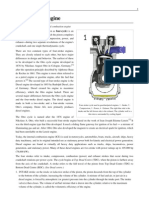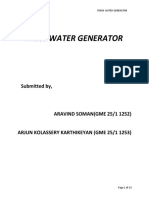Parallel Axis Theorem - Handout
Parallel Axis Theorem - Handout
Uploaded by
oflores64Copyright:
Available Formats
Parallel Axis Theorem - Handout
Parallel Axis Theorem - Handout
Uploaded by
oflores64Original Title
Copyright
Available Formats
Share this document
Did you find this document useful?
Is this content inappropriate?
Copyright:
Available Formats
Parallel Axis Theorem - Handout
Parallel Axis Theorem - Handout
Uploaded by
oflores64Copyright:
Available Formats
Parallel axis theorem
From Wikipedia, the free encyclopedia
In physics, the parallel axis theorem or Huygens-Steiner theorem can be used to determine the moment of inertia of a rigid body about any axis, given the moment of inertia of the object about the parallel axis through the object's center of mass and the perpendicular distance between the axes. The moment of inertia about the new axis z is given by:
where: is the moment of inertia of the object about an axis passing through its centre of mass; is the object's mass; is the perpendicular distance between the two axes. This rule can be applied with the stretch rule and perpendicular axis theorem to find moments of inertia for a variety of shapes. The parallel axes rule also applies to the second moment of area (area moment of inertia) for a plane region D:
where: is the area moment of inertia of D relative to the parallel axis; is the area moment of inertia of D relative to its centroid; is the area of the plane region D; is the distance from the new axis z to the centroid of the plane region D.
Parallel axes rule for area moment of inertia.
Note: The centroid of D coincides with the center of gravity (CG) of a physical plate with the same shape that has constant density.
In classical mechanics
In classical mechanics, the Parallel axis theorem (also known as Huygens-Steiner theorem) can be generalized to calculate a new inertia tensor Jij from an inertia tensor about a center of mass Iij when the pivot point is a displacement a from the center of mass:
where
is the displacement vector from the center of mass to the new axis, and
is the Kronecker delta. We can see that, for diagonal elements (when i = j), displacements perpendicular to the axis of rotation results in the above simplified version of the parallel axis theorem.
See also
Perpendicular axis theorem Stretch rule Jakob Steiner
References
Parallel axis theorem (http://scienceworld.wolfram.com/physics/ParallelAxisTheorem.html) Retrieved from "http://en.wikipedia.org/wiki/Parallel_axis_theorem" Categories: Mechanics | Introductory physics | Physics theorems This page was last modified on 26 January 2010 at 21:04. Text is available under the Creative Commons Attribution-ShareAlike License; additional terms may apply. See Terms of Use for details. Wikipedia is a registered trademark of the Wikimedia Foundation, Inc., a non-profit organization.
You might also like
- Engineering ThermodynamicsDocument57 pagesEngineering ThermodynamicsBasu SbNo ratings yet
- AUX2Document210 pagesAUX2KirsthyNo ratings yet
- HeatDocument16 pagesHeatapi-233194737No ratings yet
- Marine Engineering Questions and AnswersDocument15 pagesMarine Engineering Questions and AnswersDinesh SilvaNo ratings yet
- History of CompressorDocument24 pagesHistory of CompressorHaryNo ratings yet
- Marine Boiler Water Level ControlDocument2 pagesMarine Boiler Water Level ControlPravin KumarNo ratings yet
- B.e, Vi Sem - Ma M-II, Stg. Gear, 12!2!09Document168 pagesB.e, Vi Sem - Ma M-II, Stg. Gear, 12!2!09Salman ShukkurNo ratings yet
- Indicator DiagramsDocument9 pagesIndicator DiagramsBhupender RamchandaniNo ratings yet
- HydromechanicsDocument183 pagesHydromechanicsReza GoldaranNo ratings yet
- Function of Thermostatic Expansion Valve in Refrigeration SystemDocument5 pagesFunction of Thermostatic Expansion Valve in Refrigeration SystemSumit SinhaNo ratings yet
- Metering DevicesDocument8 pagesMetering DevicesKudzai ManyanyeNo ratings yet
- The Second Engineer DUTYDocument2 pagesThe Second Engineer DUTYДмитрий МещерскихNo ratings yet
- Fun 3 & 6 Q & A UpdatedDocument173 pagesFun 3 & 6 Q & A Updatedrajesh kumarNo ratings yet
- Thermodynamics McqsDocument31 pagesThermodynamics McqsRohitNo ratings yet
- Propeller BasicsDocument2 pagesPropeller BasicsPavan KishoreNo ratings yet
- Steering Gear Regulations-LloydsDocument15 pagesSteering Gear Regulations-Lloydsd_damn100% (2)
- 09-NAC-Numerical Integration Method (171229) - Student PDFDocument41 pages09-NAC-Numerical Integration Method (171229) - Student PDFMehedi Hossain MithilNo ratings yet
- How To Measure Indicated Power in Diesel Engine With Indicator DiagramDocument3 pagesHow To Measure Indicated Power in Diesel Engine With Indicator Diagramasme51100% (2)
- Bed Plate Main Engine BedplateDocument52 pagesBed Plate Main Engine BedplateSuhas KassaNo ratings yet
- 7 PumpsDocument13 pages7 PumpsMahmoud Ahmed Ali AbdelrazikNo ratings yet
- Lectures On Kinetic Theory of Gases and Statistical Physics: Alexander A. SchekochihinDocument157 pagesLectures On Kinetic Theory of Gases and Statistical Physics: Alexander A. SchekochihinRoy VeseyNo ratings yet
- Piston - Hce First ReviewDocument23 pagesPiston - Hce First ReviewLAKKANABOINA LAKSHMANARAONo ratings yet
- REEDS - BOILERS - PAGES 01 To 40Document40 pagesREEDS - BOILERS - PAGES 01 To 40Narendra niranjan MathiyarasuNo ratings yet
- Nozzle EtcDocument21 pagesNozzle EtcTwizer LebalengNo ratings yet
- Design and Analysis of Contra-Rotating Propeller BladeDocument27 pagesDesign and Analysis of Contra-Rotating Propeller BladeRaghavendra Raghav100% (2)
- Four Stroke Engine WorkingDocument10 pagesFour Stroke Engine WorkingMahesh KatkarNo ratings yet
- Auxiliary Marine Machinery: Under ConstructionDocument55 pagesAuxiliary Marine Machinery: Under ConstructionAbhinav100% (1)
- Propeller Theories Kerwin - Notes PDFDocument234 pagesPropeller Theories Kerwin - Notes PDFSaeed JavdaniNo ratings yet
- Mooring and Anchor Handling EquipmentDocument38 pagesMooring and Anchor Handling EquipmentTee Jay GarcesNo ratings yet
- Gioi Thieu Dong Co MANBW ME-CDocument26 pagesGioi Thieu Dong Co MANBW ME-CMitdac HP0% (1)
- Introduction To Streering Gear SystemDocument1 pageIntroduction To Streering Gear SystemNorman prattNo ratings yet
- Firing Order of CylindersDocument17 pagesFiring Order of CylindersSaurav KumarNo ratings yet
- Motor QuestionsDocument6 pagesMotor QuestionsSuhail KhanNo ratings yet
- Ship Stability - Understanding Curves of Static StabilityDocument11 pagesShip Stability - Understanding Curves of Static StabilitygeorgesagunaNo ratings yet
- Cooling Sea Water Service SystemDocument3 pagesCooling Sea Water Service SystemAustin UdofiaNo ratings yet
- Met Class 4 Electrical WrittenDocument83 pagesMet Class 4 Electrical WrittenAjeet Jha86% (7)
- Manometer Measuring TanksDocument4 pagesManometer Measuring TanksBouncer Bin100% (1)
- Basics of Power CircuitsDocument90 pagesBasics of Power Circuitsरमेश सिंहNo ratings yet
- Marine System Design ProjectDocument243 pagesMarine System Design ProjectRishi Sashank100% (1)
- Boundary Layer Theory - 1Document6 pagesBoundary Layer Theory - 1Yimkum Ozzy100% (1)
- Pressure and Enthalpy DiagramDocument13 pagesPressure and Enthalpy DiagramAravindNo ratings yet
- Be. Boiler NotesDocument60 pagesBe. Boiler Notesvinaik3100% (1)
- FWGDocument13 pagesFWGNandu SNo ratings yet
- Purifiers and ClarifiersDocument6 pagesPurifiers and ClarifiersNeville McBeanNo ratings yet
- Wake Adapted Propeller DesignDocument8 pagesWake Adapted Propeller DesignSumit DasNo ratings yet
- Parallel Operation of Three-Phase AlternatorsDocument12 pagesParallel Operation of Three-Phase AlternatorsNayan Manna100% (2)
- (PPE) Used On Board ShipDocument8 pages(PPE) Used On Board ShipVincent TorenoNo ratings yet
- Marine Pumps CentrifugalDocument16 pagesMarine Pumps CentrifugalViet Le-DucNo ratings yet
- How and Why To Take Manual Sounding On ShipDocument4 pagesHow and Why To Take Manual Sounding On ShipBea Heart GargaceranNo ratings yet
- Ship Construction Terms: Posted In: - TaggedDocument7 pagesShip Construction Terms: Posted In: - TaggedASIT DASNo ratings yet
- Friction Laws of Dry Friction-Pivot and CollarDocument25 pagesFriction Laws of Dry Friction-Pivot and CollarNavya ChinniNo ratings yet
- L27 - The Brayton CycleDocument12 pagesL27 - The Brayton CycleHaliunaa BatboldNo ratings yet
- Incinerators On ShipsDocument4 pagesIncinerators On ShipsVishu SharmaNo ratings yet
- 12 MARINE Air CompressorDocument13 pages12 MARINE Air CompressorTuhin HandaNo ratings yet
- Reed's Naval Architecture Centre of GravityDocument7 pagesReed's Naval Architecture Centre of GravityIshan Bhatnagar100% (1)
- Internal Combustion EngineDocument4 pagesInternal Combustion Enginesari hafizhNo ratings yet
- 20 MARIN Steering GearDocument20 pages20 MARIN Steering GearTuhin Handa100% (1)
- Parallel Axis TheoremDocument3 pagesParallel Axis TheoremKareem Ibrahim Mohamed NasrNo ratings yet
- Physics Assignment 4th SemesterDocument11 pagesPhysics Assignment 4th SemesterMuzaffar Salik100% (1)
- Module 7 - Chapter 7Document17 pagesModule 7 - Chapter 7tenderNo ratings yet



























































